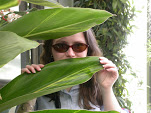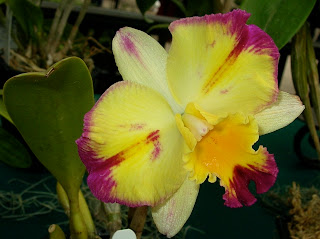 While I could prattle on about all the other Cattleya alliance species we saw - there were several very attractive examples - I think I'll round out this image-rich post with a photo of one of my favorite hybrids. This is Slc. Fire Magic 'H&R'. I like Fire Magic for the variety of patterns you see in the flowers, as well as their compact, easy-growing nature. I got a batch of seedlings myself last year, and I'm waiting to see many of them bloom for the first time. I hope this summer will be it for many of them. Unbloomed seedlings are available from my Etsy shop.
While I could prattle on about all the other Cattleya alliance species we saw - there were several very attractive examples - I think I'll round out this image-rich post with a photo of one of my favorite hybrids. This is Slc. Fire Magic 'H&R'. I like Fire Magic for the variety of patterns you see in the flowers, as well as their compact, easy-growing nature. I got a batch of seedlings myself last year, and I'm waiting to see many of them bloom for the first time. I hope this summer will be it for many of them. Unbloomed seedlings are available from my Etsy shop.
Sunday, March 28, 2010
2010 SEPOS Show, Cattleya Alliance Selections
I'm going to break up my selections of photos from the South East Pennsylvania Orchid Show again into a couple installments. I came away this year with >150 photos after curation. I started with over 300 photos, as I generally take multiple shots per plant, keeping the best one or two, as well as a snap of the plant's tag, which is deleted after renaming the photos. Since I don't often talk about Cattleya alliance plants, I'll start with those this year.
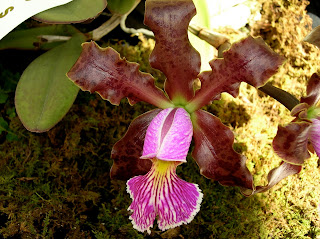 Cattleya schilleriana has long been one of my favorite species (though, admittedly, I have many "favorites"). It is a medium sized bifoliate species with heavy, glossy flowers of rich color and, like many Cattleyas, heavy fragrance. I thought this one was very nice - it was quite dark. If I remember correctly it was in the Fishing Creek exhibit. Fishing Creek got an FCC on one of their cattleya hybrids, I was unable to get a good photo of that plant. It was perfectly flat, very round, and had a most unusual near solid watermelon shade. I'll bet it shows up in Awards Quarterly.
Cattleya schilleriana has long been one of my favorite species (though, admittedly, I have many "favorites"). It is a medium sized bifoliate species with heavy, glossy flowers of rich color and, like many Cattleyas, heavy fragrance. I thought this one was very nice - it was quite dark. If I remember correctly it was in the Fishing Creek exhibit. Fishing Creek got an FCC on one of their cattleya hybrids, I was unable to get a good photo of that plant. It was perfectly flat, very round, and had a most unusual near solid watermelon shade. I'll bet it shows up in Awards Quarterly.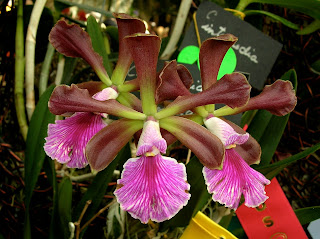 Also in the show (in a different display) was this schilleriana hybrid, Cattleya schilleriana x Enc. cordigera. See a photo of the species Enc. cordigera at ISOPE for reference. Obviously, as both parents posses dark petals, the offspring does as well, but the spots are gone and the striping of schilleriana comes through on the lip, while the size of the lip comes from cordigera. Schilleriana has flattened it out a bit as well. And of course, thanks to both parents it is sweetly fragrant. I'm going to have to seek this hybrid out. If anyone knows of flasks or compots for sale, please point me in the right direction!
Also in the show (in a different display) was this schilleriana hybrid, Cattleya schilleriana x Enc. cordigera. See a photo of the species Enc. cordigera at ISOPE for reference. Obviously, as both parents posses dark petals, the offspring does as well, but the spots are gone and the striping of schilleriana comes through on the lip, while the size of the lip comes from cordigera. Schilleriana has flattened it out a bit as well. And of course, thanks to both parents it is sweetly fragrant. I'm going to have to seek this hybrid out. If anyone knows of flasks or compots for sale, please point me in the right direction!
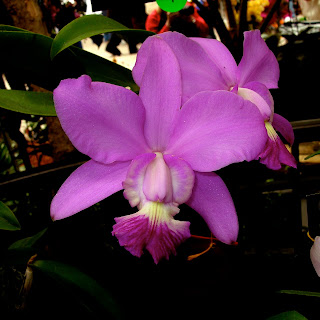
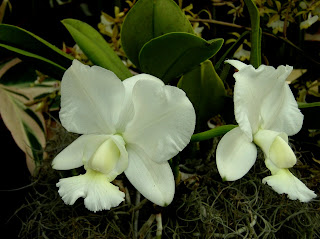
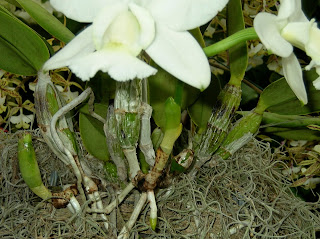 As expected, there were several examples of Cattleya walkeriana to enjoy. This is a very compact species, generally between 6 and 8 inches tall, and in my opinion, best grown mounted, but I almost always see them in pots so likely I'm the one of the few who thinks that way. C. walkeriana is always a lovely thing, available in pink, white, white with pink lip, and "blue" (which is really a weird purple shade), and always with a rose fragrance. The most interesting thing about the species is the unique way the flowers are borne. Most cattleyas and relatives of cattleyas bear their flowers from within the leaf axil at the top of a mature pseudobulb. C. walkeriana, however, sprouts the flowers from an odd little growth with no other purpose from the base of a mature pseudobulb. The third picture shows this if you look closely - you'll see the mature growth center-left, with its papery protections, and center right the flower stem with bracts. The exception to this rule for walkeriana is the clone C. walkeriana v. alba 'Pendentive'. Pendentive is believed to be a tetraploid, because the flowers and growths are exceptionally thick and hard (like heavy cardboard), and suspected by some to not actually be walkeriana because it bears its flowers like any other cattleya.
As expected, there were several examples of Cattleya walkeriana to enjoy. This is a very compact species, generally between 6 and 8 inches tall, and in my opinion, best grown mounted, but I almost always see them in pots so likely I'm the one of the few who thinks that way. C. walkeriana is always a lovely thing, available in pink, white, white with pink lip, and "blue" (which is really a weird purple shade), and always with a rose fragrance. The most interesting thing about the species is the unique way the flowers are borne. Most cattleyas and relatives of cattleyas bear their flowers from within the leaf axil at the top of a mature pseudobulb. C. walkeriana, however, sprouts the flowers from an odd little growth with no other purpose from the base of a mature pseudobulb. The third picture shows this if you look closely - you'll see the mature growth center-left, with its papery protections, and center right the flower stem with bracts. The exception to this rule for walkeriana is the clone C. walkeriana v. alba 'Pendentive'. Pendentive is believed to be a tetraploid, because the flowers and growths are exceptionally thick and hard (like heavy cardboard), and suspected by some to not actually be walkeriana because it bears its flowers like any other cattleya.
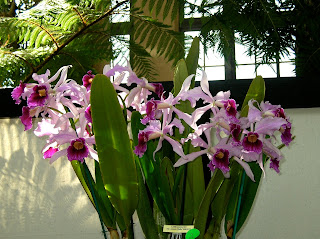 There were many other species displayed as well. One I was particularly impressed with was this enormous Laelia purpurata var. venosa 'Bella' AM/AOS. This variety is unique in the striping of the lip. Last year I purchased a flask of Laelia purpurata (v. venosa x v. schusteriana), and have recently made the youngsters available in my shop. I'd never actually seen either variety in person, so this was doubly exciting. The babies have several years of growing to do before they're quite that large, but hopefully they'll be convinced to at least bloom for the first time in 4-5 years.
There were many other species displayed as well. One I was particularly impressed with was this enormous Laelia purpurata var. venosa 'Bella' AM/AOS. This variety is unique in the striping of the lip. Last year I purchased a flask of Laelia purpurata (v. venosa x v. schusteriana), and have recently made the youngsters available in my shop. I'd never actually seen either variety in person, so this was doubly exciting. The babies have several years of growing to do before they're quite that large, but hopefully they'll be convinced to at least bloom for the first time in 4-5 years.
 While I could prattle on about all the other Cattleya alliance species we saw - there were several very attractive examples - I think I'll round out this image-rich post with a photo of one of my favorite hybrids. This is Slc. Fire Magic 'H&R'. I like Fire Magic for the variety of patterns you see in the flowers, as well as their compact, easy-growing nature. I got a batch of seedlings myself last year, and I'm waiting to see many of them bloom for the first time. I hope this summer will be it for many of them. Unbloomed seedlings are available from my Etsy shop.
While I could prattle on about all the other Cattleya alliance species we saw - there were several very attractive examples - I think I'll round out this image-rich post with a photo of one of my favorite hybrids. This is Slc. Fire Magic 'H&R'. I like Fire Magic for the variety of patterns you see in the flowers, as well as their compact, easy-growing nature. I got a batch of seedlings myself last year, and I'm waiting to see many of them bloom for the first time. I hope this summer will be it for many of them. Unbloomed seedlings are available from my Etsy shop.
 While I could prattle on about all the other Cattleya alliance species we saw - there were several very attractive examples - I think I'll round out this image-rich post with a photo of one of my favorite hybrids. This is Slc. Fire Magic 'H&R'. I like Fire Magic for the variety of patterns you see in the flowers, as well as their compact, easy-growing nature. I got a batch of seedlings myself last year, and I'm waiting to see many of them bloom for the first time. I hope this summer will be it for many of them. Unbloomed seedlings are available from my Etsy shop.
While I could prattle on about all the other Cattleya alliance species we saw - there were several very attractive examples - I think I'll round out this image-rich post with a photo of one of my favorite hybrids. This is Slc. Fire Magic 'H&R'. I like Fire Magic for the variety of patterns you see in the flowers, as well as their compact, easy-growing nature. I got a batch of seedlings myself last year, and I'm waiting to see many of them bloom for the first time. I hope this summer will be it for many of them. Unbloomed seedlings are available from my Etsy shop.
Labels:
orchid show photos,
orchids
Saturday, March 20, 2010
Clivia show at Longwood Gardens
Last weekend, a clivia show was held at Longwood Gardens. I did not attend, but my buddy Ogecko did, and has shared his photos with us. He reports that there were only Clivia miniata plants on display, no other species, but there were at least a variety of color types. He also got a chance to see the Longwood clivia house, not normally open to the public. There are two photos at the bottom of this production house.








Wednesday, March 17, 2010
In Bloom, Office Edition

 Please forgive the less than fantastic images. These were taken with my cell phone. The plant you are squinting at is Phal. mannii v. flava (this plant is for sale - click here), a variety of the species mannii that does not produce the red pigments, most likely a carotenoid pigment, but I'm not sure. If you look closely at the actual flower (in person), you can still see the markings where the red pigments belong. The leaves also are devoid of any red pigmentation.
Please forgive the less than fantastic images. These were taken with my cell phone. The plant you are squinting at is Phal. mannii v. flava (this plant is for sale - click here), a variety of the species mannii that does not produce the red pigments, most likely a carotenoid pigment, but I'm not sure. If you look closely at the actual flower (in person), you can still see the markings where the red pigments belong. The leaves also are devoid of any red pigmentation.This is my office window in Baltimore, MD, facing due west. I also currently have there a Dischidia ovata (almost always with buds or flowers), Clivia manata (in the darker corner), Dend. Maiden Charlotte, and a equitant oncidium in the brightest corner for the cold season only - that will go outside at the earliest opportunity.
Sunday, March 14, 2010
In Bloom: Phal Fantasy Musick seedlings
These are three adorable little Phal. Fantasy Musick seedlings, blooming for the first time. Fantasy Musick is a hybrid of (Micro Nova x equestris). Micro Nova can be traced back to Phal lobbii, and both it and equestris are compact species. These guys are blooming in 2" pots with multiple flowers and several pairs of leaves. They'll always be small, cute plants. The downside is as lobbii offspring, they can be expected to not breed well. I hold out some small hope that the infusion of equestris genetics will make them more compatible with general phalaenopsis population. We'll see.
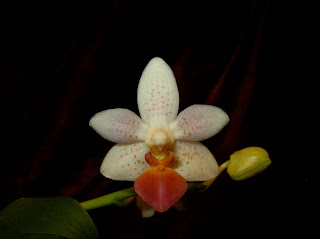
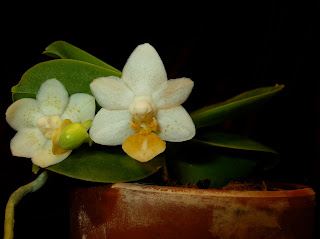
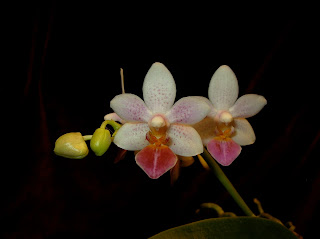
Friday, March 12, 2010
USBG Production Facility Tour
 Once again, we took the annual opportunity to visit the US Botanical Gardens production facility this past weekend. They have an open house every spring, and it is a wonderful opportunity to see parts of their collection that you may not otherwise see. You can see photos from last year here.
Once again, we took the annual opportunity to visit the US Botanical Gardens production facility this past weekend. They have an open house every spring, and it is a wonderful opportunity to see parts of their collection that you may not otherwise see. You can see photos from last year here.This year, not as much was in bloom, likely due to the cooler winter, or perhaps much of it had just been moved off-site for use in the conservatory or participation in various plant shows. As always, we were treated to several nobile-type dendrobiums and their lovely bank of Paph. victoria-regina specimens (upper left).
They also have a succulent collection with an interesting variety of this & that. There were a number of Euphorbias there I don't remember seeing before, and a few miniature Aloes. Aloes are a new fascination with me. I am especially fond of the miniatures.
Euphorbia horrida var. striata
Aloe humilis
Aloe aristata
Subscribe to:
Posts (Atom)
